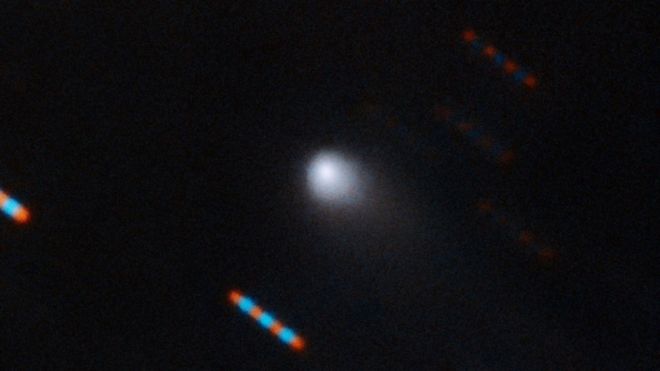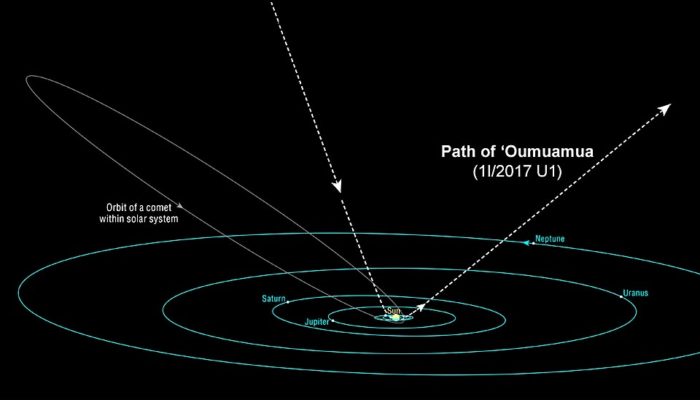Sep 19 2019
Potential Second Interstellar Object
 In 2017 astronomers detected and confirmed the first interstellar object, an asteroid from another solar system racing through our own – Oumuamua. The object is long and thin, like a cigar, and appears to have some outgassing altering its trajectory. So it’s not quite a comet, but not just a rock either. We didn’t detect Oumuamua until after it has passed by its closest approach to the Earth. It whipped around the sun and is now heading up out of the plane of our solar system.
In 2017 astronomers detected and confirmed the first interstellar object, an asteroid from another solar system racing through our own – Oumuamua. The object is long and thin, like a cigar, and appears to have some outgassing altering its trajectory. So it’s not quite a comet, but not just a rock either. We didn’t detect Oumuamua until after it has passed by its closest approach to the Earth. It whipped around the sun and is now heading up out of the plane of our solar system.
We know Oumuamua is an interstellar object because it is going very fast and is on a trajectory that is not bound to the sun. There are two interesting aspects to Oumuamua. The first is that it is changing course slightly, as if it is outgassing, but we don’t see the outgassing. It is not a regular comet. The second is that its course was aimed, on a cosmic scale, right at the sun. If you look at the path (below) and extrapolate out to interstellar distances, that is a phenomenal bullseye. If you do the math, and one astronomer did, the probability of such a close encounter with an interstellar object is 100 million to one.
Oumuamua came within 0.25 AU of the sun and 0.15 AU of the Earth. If this were random, they calculate that stellar systems on average would have to eject 10^15 such objects – which is 100 million times more than projected. That means that our chance encounter with Oumuamua was a 1 in 100 million chance – that’s like winning the interstellar lottery. This lead that astronomer to speculate that perhaps Oumuamua is not a random asteroid, but a ship that was aimed at our sun. Perhaps solar sails explain the course change without visible outgassing.
Whenever astronomers encounter a new or unusual phenomenon, someone argues that it’s aliens. So far, every time a natural origin has been eventually discovered. This case is likely to be no different. And in this case there was an obvious test – if the encounter with Oumuamua was random, this suggests that interstellar objects are more common than we previously projected. If this is true then we should start finding more interstellar objects. You can see where this is going, especially with the title of this post.
Recently an amateur astronomer, Gennady Borisov, discovered a comet named C/2019 Q4 (nicknamed Borisov after its discoverer). Borisov (the comet) appears to be on a trajectory not bound by the sun and traveling fast, so it will pass through our solar system. It is therefore likely an interstellar comet – discovered just two years after Oumuamua. Borisov is much larger, 3-17km (Oumuamua is just 170 meters), and is clearly outgassing, so it’s a straight-up comet. We also detected it prior to its close approach, which will be in December.
 It’s difficult to calculate statistics with an N of 1. Now that we have a second interstellar object we can make better calculations about how common they are, which does at least decrease that 100 million to one odds. Perhaps Oumuamua was still a freak chance, but just not as much as assumed.
It’s difficult to calculate statistics with an N of 1. Now that we have a second interstellar object we can make better calculations about how common they are, which does at least decrease that 100 million to one odds. Perhaps Oumuamua was still a freak chance, but just not as much as assumed.
We also have an opportunity to study the composition of Borisov with spectral analysis. The question is – is Borisov similar or different than comets from our own solar system? Either way, the answer will be interesting. We may learn what is unique about the comets in our own system, their signature, and how comets from other parts of the galaxy differ. Or we may find that our comets are typical, and that comets throughout the galaxy may be mostly similar. This may further have implications for the potential for life, as comets carry organic compounds that may have been critical to seeding the early Earth with raw materials necessary for life.
At this point Boris is still just a potential interstellar object, because we need to track its trajectory for longer in order to confirm it’s path. We could then backtrack to its origin, at least to what region of the galaxy it came from. Of course it may have pinballed around before getting to us, just like any far future astronomers encountering Oumuamua would trace its “origin” to our own solar system.
One question I have about Borisov – could it be from our own Oort cloud, a distant sphere of icy objects around our sun that is the source of long-period comets? It may be going to fast for that, but further analysis of its trajectory should answer the question.
There is more information to be gleaned from Borisov, and given that we only had to wait two years to discover a likely second interstellar object there is probably more in our near future.






